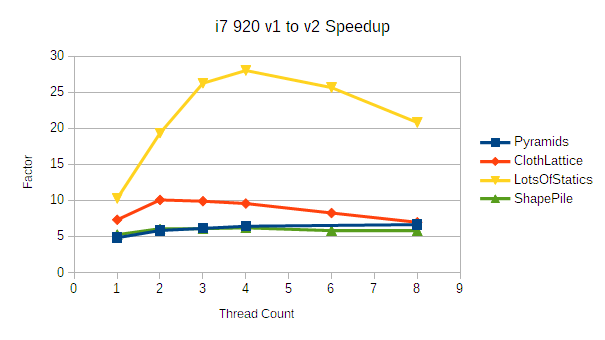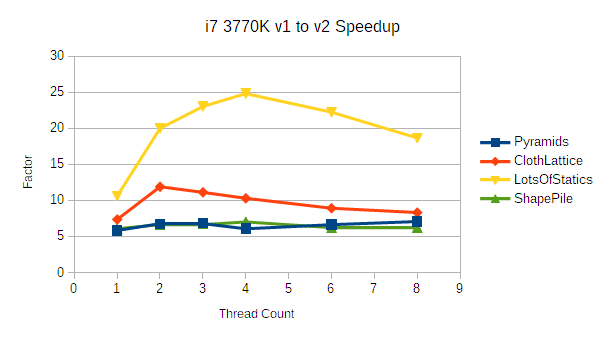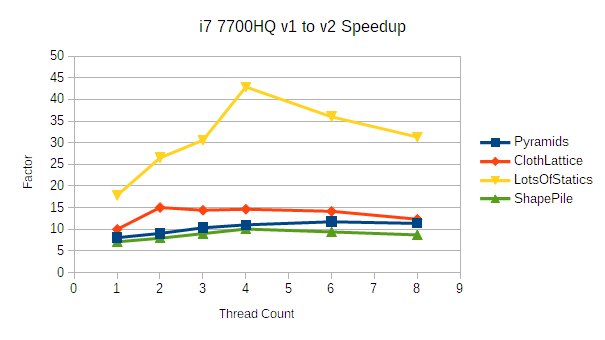It's time for benchmarks!
Historically, performance improvements in BEPUphysics v1 came incrementally. Each new big version came with a 20% boost here, another 10% over there, gradually accumulating to make v1.5.1 pretty speedy.
The jump from v1.5.1 to v2.0.0, even in its alpha state, is not incremental.

That's a change from about 120 ms per frame in v1 to around 9.5 ms in v2 when using 8 threads. The difference is large enough that the graph gets a little difficult to interpret, so the remaining graphs in this post will just show the speedup factor from v1 to v2.
Benchmarks
The benchmarks cover four test cases:- Cloth lattice composed of 16384 spheres and 64470 ball socket constraints. Deactivation disabled.
- 20 pyramids, each containing 210 boxes. Deactivation disabled.
- Lots of statics with inactive bodies resting on top. 4096 inactive bodies, 9216 statics.
- Collapsing pile of boxes, capsules, and spheres. 4096 total bodies. Deactivation disabled.
If you'd like to run the benchmarks yourself, grab the benchmarks source from github: github.com/RossNordby/scratchpad/tree/master/Benchmarks
I bugged a bunch of people with different processors to run the benchmarks. Some of these benchmarks were recorded with minor background tasks, so it's a fairly real world sample. All benchmarks ran on Windows 10 with .NET Core 2.0.6.
Results
First, two processors that use 128 bit SIMD:

ShapePile and Pyramids both require quite a bit of narrow phase work which involves a chunk of scalar bookkeeping. With fewer opportunities for vectorization, they don't benefit as much as the extremely solver heavy ClothLattice benchmark.
Note that the ClothLattice benchmark tends to allow v1 to catch up a little bit at higher core counts. This is largely because of limited memory bandwidth. The solver is completely vectorized apart from the bare minimum of gathers and scatters, so it's difficult to fetch constraints from memory as quickly as the cores can complete the ALU work. v1, in contrast, was just a giant mess of cache misses, and it's very easy for cores to idle in parallel.
LotsOfStatics is another interesting case: statics and inactive bodies are placed into an extremely low cost state compared to v1. In fact, the only stage that is aware of those objects at all is the broad phase, and the broad phase has a dedicated structure for inactive bodies and statics. In terms of absolute performance, the LotsOfStatics benchmark took under 350 microseconds per frame with 8 threads on the 3770K.
Notably, this is an area where v2 still has room for improvement. The broad phase is far too aggressive about refining the static structure; I just haven't gotten around to improving the way it schedules refinements yet. This particular benchmark could improve by another factor of 2-4 easily.
Now for a few AVX2-capable processors:



There are some pretty interesting things going on here. Most noticeably, the 7700HQ shows a much larger improvement across the board than any of the other processors tested. This is expected when comparing against the 128-wide platforms (3770K and 920) thanks to the significantly higher floating point throughput. The ClothLattice demo in particular shows a speedup of 10-15x compared to the 3770K's 7.4-11.9x.
While I haven't verified this with direct measurement, I suspect the 7700HQ benefits more than the AVX2 capable 4790K and 1700X thanks to its significantly higher effective memory bandwidth per core. The 4790K roughly matches the non-AVX2 3770K in bandwidth, and 1700X actually has significantly less bandwidth per core than the 3770K. The memory bandwidth hungry ClothLattice benchmark timings are consistent with this explanation- both the 4790K and 1700X show noticeably less benefit with higher core counts compared to the 7700HQ.
Zen's AVX2 implementation also has slightly different performance characteristics. I have not done enough testing to know how much this matters. If RyuJIT is generating a bunch of FMA instructions that I've missed, that could contribute to the 7700HQ's larger improvement.
There also a peculiar massive improvement in the LotsOfStatics demo, topping out at 42.9x faster on the 7700HQ. That's not something I expected to see- that benchmark spends most of its time in weakly vectorized broadphase refinements. I haven't yet done a deep dive on refinement performance (it's slated to be reworked anyway), but this could be another area where the 7700HQ's greater bandwidth is helpful.
Summary
v2 is vastly faster than v1. It's not just a way to save money on server hardware or to allow for a few more bits of cosmetic debris- it's so much faster that it can be used to make something qualitatively different.
And it's going to get faster!
